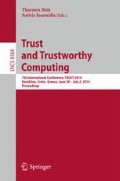Abstract
As the web expands in size and adoption, so does the interest of attackers who seek to exploit web applications and exfiltrate user data. While there is a steady stream of news regarding major breaches and millions of user credentials compromised, it is logical to assume that, over time, the applications of the bigger players of the web are becoming more secure. However, as these applications become resistant to most prevalent attacks, adversaries may be tempted to move to easier, unprotected targets which still hold sensitive user data.
In this paper, we report on the state of security for more than 22,000 websites that originate in 28 EU countries. We first explore the adoption of countermeasures that can be used to defend against common attacks and serve as indicators of “security consciousness”. Moreover, we search for the presence of common vulnerabilities and weaknesses and, together with the adoption of defense mechanisms, use our findings to estimate the overall security of these websites. Among other results, we show how a website’s popularity relates to the adoption of security defenses and we report on the discovery of three, previously unreported, attack variations that attackers could have used to attack millions of users.
Access this chapter
Tax calculation will be finalised at checkout
Purchases are for personal use only
Preview
Unable to display preview. Download preview PDF.
References
Bing Search API, http://datamarket.azure.com/dataset/bing/search
Common Vulnerability Scoring System (CVSS), http://www.first.org/cvss
Common Weakness Scoring System (CWSS), https://cwe.mitre.org/cwss/
OWASP Top Ten Project, https://www.owasp.org/index.php/Category:OWASP_Top_Ten_Project
Phantomjs: Headless webkit with javascript api, https://www.phantomjs.org/
Alarifi, A., Alsaleh, M., Al-Salman, A.: Security analysis of top visited arabic web sites. In: 2013 15th International Conference on Advanced Communication Technology (ICACT), pp. 173–178. IEEE (2013)
Balduzzi, M., Gimenez, C.T., Balzarotti, D., Kirda, E.: Automated Discovery of Parameter Pollution Vulnerabilities in Web Applications. In: 18th Annual Network and Distributed System Security Symposium, San Diego, USA (2011)
Barth, A.: HTTP state management mechanism. IETF RFC (2011)
Barth, A., Jackson, C., Mitchell, J.C.: Robust defenses for cross-site request forgery. In: Proceedings of the 15th ACM conference on Computer and communications security, CCS 2008, pp. 75–88. ACM, New York (2008)
Canali, D., Balzarotti, D., Francillon, A.: The role of web hosting providers in detecting compromised websites. In: Proceedings of the 22nd International Conference on World Wide Web, WWW 2013, pp. 177–188 (2013)
Chen, P., Nikiforakis, N., Huygens, C., Desmet, L.: A Dangerous Mix: Large-scale analysis of mixed-content websites. In: Proceedings of the 16th Information Security Conference, ISC 2013, Dallas, USA (2013)
Thai Duong and Juliano Rizzo. Here Come The ⊕ Ninjas (2011)
Hodges, J., Jackson, C., Barth, A.: HTTP strict transport security (HSTS). IETF RFC (2012)
Kals, S., Kirda, E., Kruegel, C., Jovanovic, N.: Secubat: a web vulnerability scanner. In: Proceedings of the 15th International Conference on World Wide Web, pp. 247–256. ACM (2006)
Lekies, S., Stock, B., Johns, M.: 25 million flows later: large-scale detection of dom-based xss. In: Proceedings of the 2013 ACM SIGSAC Conference on Computer & Communications Security, pp. 1193–1204. ACM (2013)
Lundeen, R., Ou, J., Rhodes, T.: New ways i’m going to hack your web app. (2011)
Marlinspike, M.: New tricks for defeating ssl in practice. Blackhat (2009)
Microsoft: IE8 Security Part IV: The XSS Filter (2008)
Nikiforakis, N., Invernizzi, L., Kapravelos, A., Acker, S.V., Joosen, W., Kruegel, C., Piessens, F., Vigna, G.: You are what you include: large-scale evaluation of remote javascript inclusions. In: Proceedings of the 2012 ACM Conference on Computer and Communications security, CCS 2012, pp. 736–747. ACM, New York (2012)
Nikiforakis, N., Younan, Y., Joosen, W.: HProxy: Client-side detection of SSL stripping attacks. In: Proceedings of the 7th Conference on Detection of Intrusions and Malware & Vulnerability Assessment, DIMVA 2010 (2010)
Rizzo, J., Duong, T.: Crime: Compression ratio info-leak made easy. In: Ekoparty Security Conference (2012)
Ross, D., Gondrom, T.: HTTP Header X-Frame-Options. IETF RFC (2013)
Sellers, D.: ASP.NET 2.0 and the new HTTP-only property. MSDN Blogs (March 2006)
Son, S., Shmatikov, V.: The postman always rings twice: Attacking and defending postmessage in html5 websites
Stamm, S., Sterne, B., Markham, G.: Reining in the web with content security policy. In: Proceedings of the 19th International Conference on World Wide Web, WWW 2010, pp. 921–930. ACM, New York (2010)
Sterne, B., Barth, A.: Content Security Policy 1.0. W3C Candidate Recommendation (2012)
Vasek, M., Moore, T.: Identifying Risk Factors for Webserver Compromise. In: Proceedings of the Eighteenth International Conference on Financial Cryptography and Data Security, FC 2014 (2014)
West, M.: Play safely in sandboxed iframes (2013)
WhiteHat. Website Security Statistics Report, https://www.whitehatsec.com/resource/stats.html
Zeller, W., Felten, E.W.: Cross-site request forgeries: Exploitation and prevention. The New York Times, 1–13 (2008)
Author information
Authors and Affiliations
Editor information
Editors and Affiliations
Rights and permissions
Copyright information
© 2014 Springer International Publishing Switzerland
About this paper
Cite this paper
van Goethem, T., Chen, P., Nikiforakis, N., Desmet, L., Joosen, W. (2014). Large-Scale Security Analysis of the Web: Challenges and Findings. In: Holz, T., Ioannidis, S. (eds) Trust and Trustworthy Computing. Trust 2014. Lecture Notes in Computer Science, vol 8564. Springer, Cham. https://doi.org/10.1007/978-3-319-08593-7_8
Download citation
DOI: https://doi.org/10.1007/978-3-319-08593-7_8
Publisher Name: Springer, Cham
Print ISBN: 978-3-319-08592-0
Online ISBN: 978-3-319-08593-7
eBook Packages: Computer ScienceComputer Science (R0)

